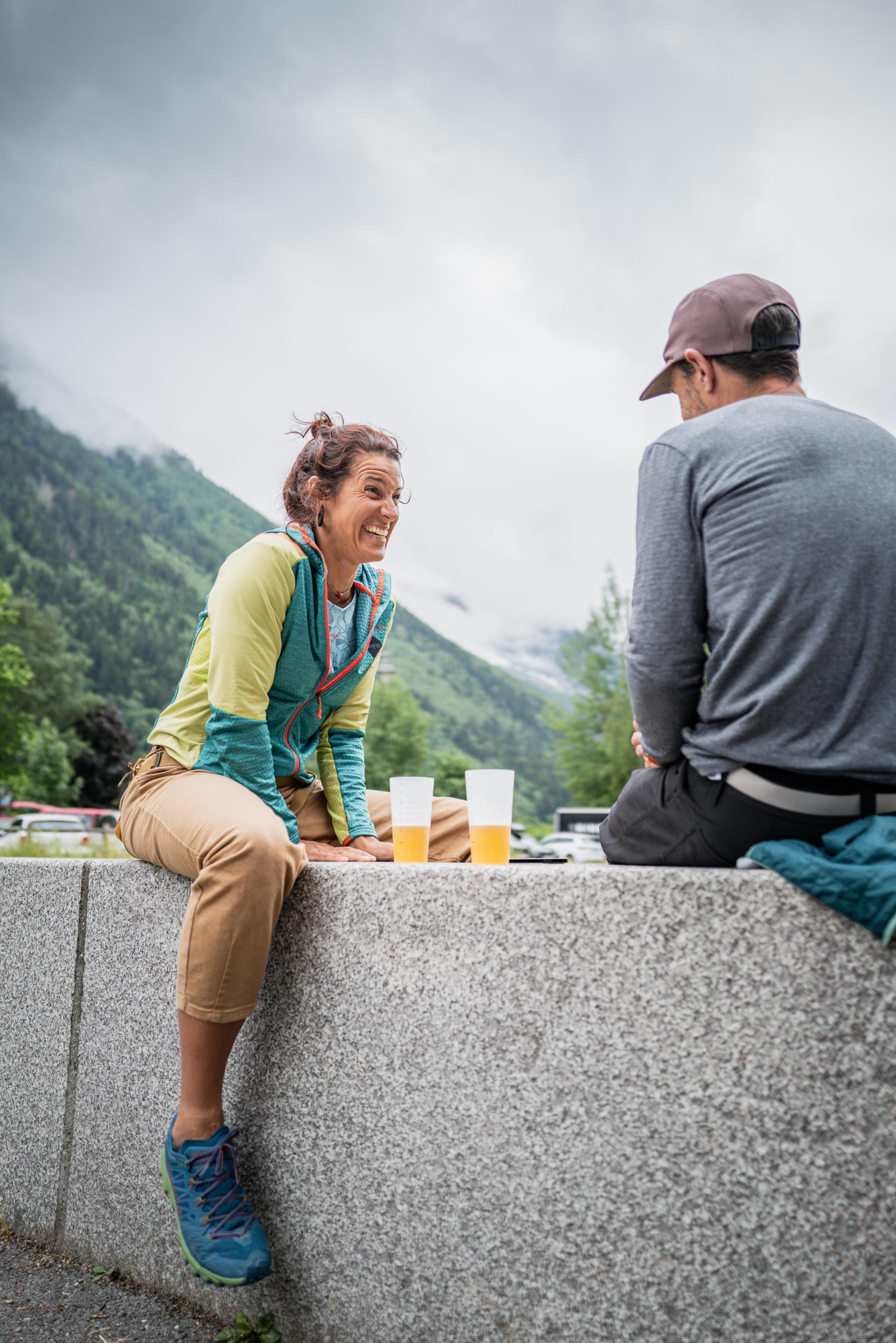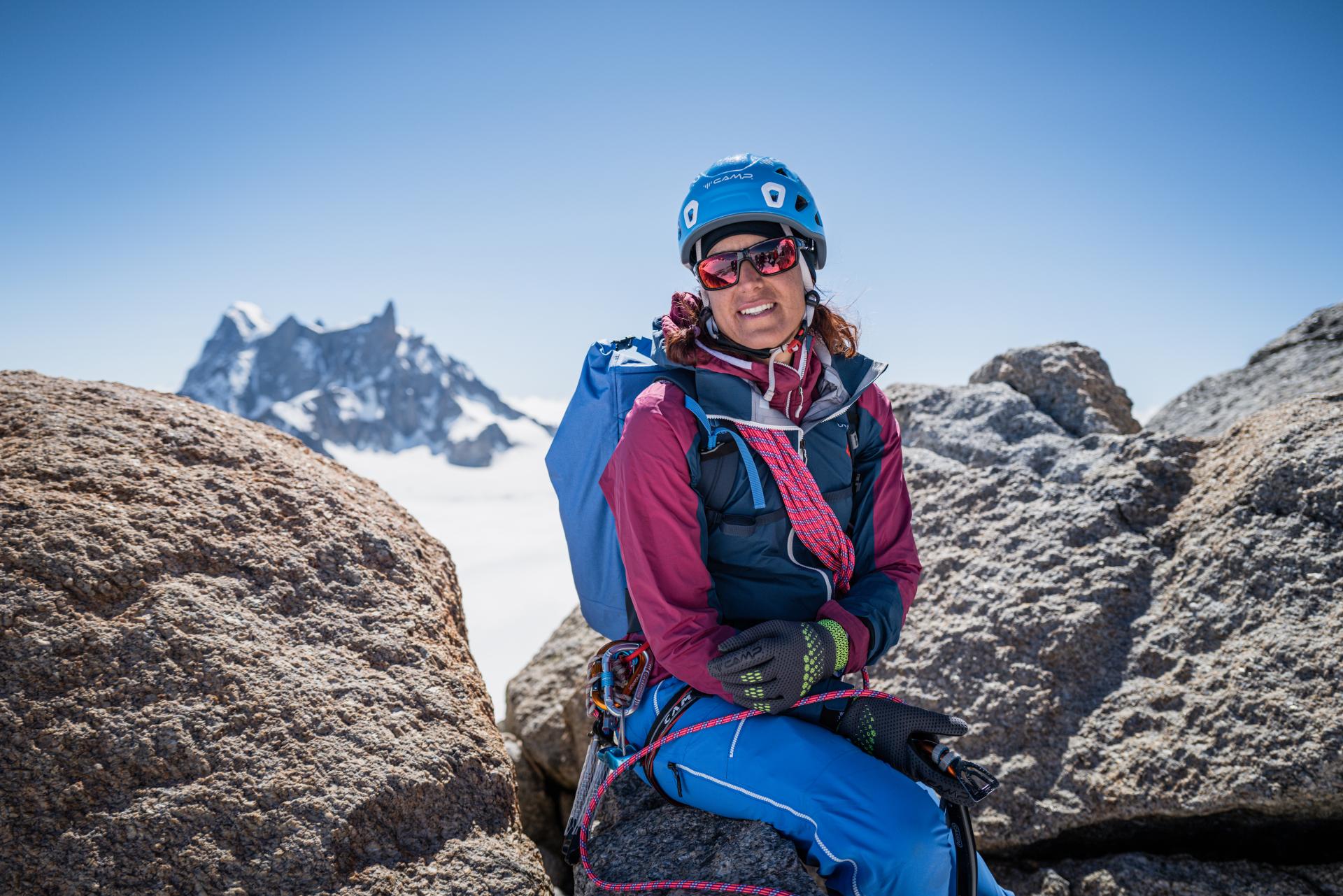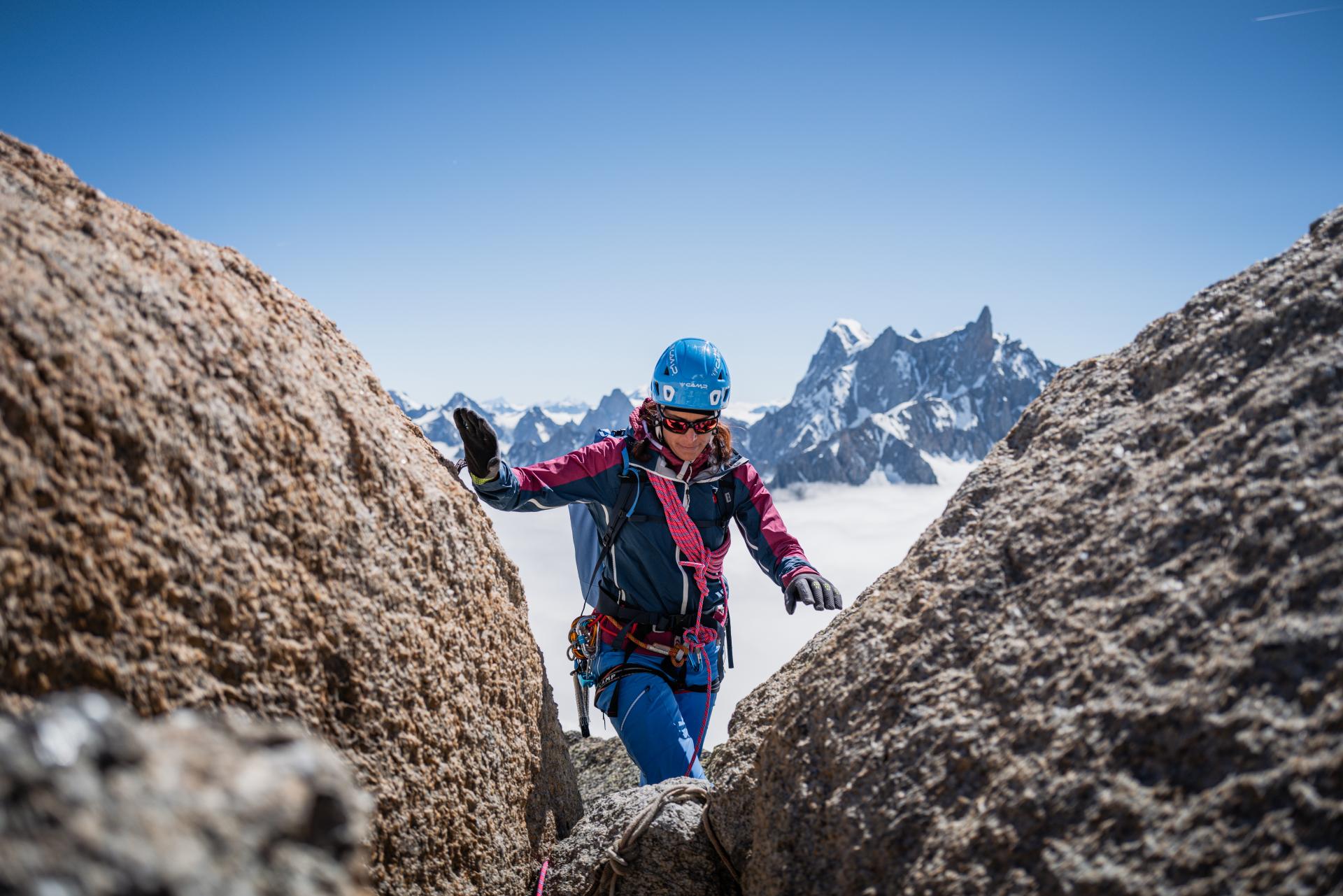PART ONE - A WOMAN OF STRONG VALUES
People often go into the mountains to find themselves, but the mountains give no guarantee about the process through which this might happen. Sometimes it happens through beauty and triumph, other times it can happen through tragedy. In both cases, these moments can change us to our core. Famous Italian mountaineer, Tamara Lunger, has experienced the full gamut of these experiences, from the joys of being the youngest woman to stand on the summit of Lhotse in 2010 (8,516 meters), to the soul-wrenching horror of holding friends as they took their last breaths on the side of a mountain.
I had the pleasure of sitting on a stone wall in the Parc Couttet, at the base of Mont Blanc in Chamonix at the Arc’teryx Alpine Academy, beer in hand, for a wide-ranging conversation with Tamara about her early forays into the mountains and her most recent experiences and transformation.
The interview is broken into three parts for ease of reading.
 The interviewer and Tamara sharing a beer and a laugh in Chamonix (Photo by Philipp Reiter)
The interviewer and Tamara sharing a beer and a laugh in Chamonix (Photo by Philipp Reiter)
Tamara, how did you first get into the mountains?
My dad would go ski touring and he would invite me. At first, I was not interested, and then at the age of fourteen I thought I would like to try it. On the first uphill I instantly thought “My God, this is so awesome”, because, you know, I love to be exhausted. Since I was a child, I was only satisfied when I would fall into my bed at the end of a day from fatigue. Skiing gave me that.
At first, I couldn’t ski downhill, I would fall rather than turn, but I decided I want to become a ski mountaineer. I started immediately with vertical, uphill races and progressed from there teaching myself to ski. I eventually made it onto the Italian national ski mountaineering team, but in the back of my mind from the age of those early tours, my wish was always to climb 8,000-meter peaks.
Where did the inspiration to climb 8,000-meter peaks come from?
I read an article in the newspaper about an Italian Olympic Nordic skier, Manuela Di Centa. She did Everest and I said, “This will be my future!” My idol was Gerlinde Kaltenbrunner: the first woman to climb all fourteen eight-thousanders without the use of oxygen. She climbed her first eight thousander when she was 23, which coincidentally was when I stood on top of my first 8,000-meter peak.
Did you instantly pursue the high mountains then?
Ski mountaineer racing was a big focus, but there was a certainty inside me that I would get there, but I didn't put too much focus on it. I knew that when the time was right, I would be there. It was something I dreamed about every day.
What eventually pulled you over?
At the end of high school, I invited one of my teachers to a year-end party and she brought her husband, (famous Italian alpinist) Simone Moro, with her. We started talking about his climbs to the greater ranges and that night I made him promise to take me to the Himalayas.
What an incredible bit of luck!
Yes, but I did not hear from him for years, and then when Facebook came along I wrote him: “Simone, listen, when do you want to bring me to the Himalayas?” He remembered our conversation and he said, yeah, maybe I can arrange that, let's see. And then, on the third of April 2009, he said to me, you can come with us. I thought “Wow, this was the best day of my life!”
 Tamara above the Vallee Blanche in Chamonix (Photo by Philipp Reiter)
Tamara above the Vallee Blanche in Chamonix (Photo by Philipp Reiter)
Wow, so Facebook is how you ended up fulfilling a dream? I know you were racing during this period, were you also developing other mountain skills because they can be quite different?
Yes, I would do a bit of everything in the mountains, climbing, skiing. I was always looking for adventure, and developing skills because I knew what I wanted my future in the mountains to look like.
Tell me about that first trip with Simone.
I was 23 years old, like my idol Gerlinde. I was so excited. We wanted to climb Cho Oyu, (the sixth-highest mountain at 8,188 meters on the China-Nepal border).
We acclimated in the Khumbu Valley on Island Peak. We slept below the summit, and I had a terrible headache all night, but the next morning after I went out of the tent, I saw this beautiful panorama, and I forgot about the pain. It was incredible.
And then the Chinese closed the border, so we weren’t able to get to Cho Oyu. I was very disappointed, but Simone said, “I may have an option for you. You can go with thirteen Russians to Lhotse” (the fourth highest mountain at 8,516 meters in the Everest massif).
Wait what? That is wild, as a 23-year-old to join thirteen unknown Russians on the mountain? That is a crazy story. Was Simone with you?
Yes, but he was there with a client, so he did not climb with me. Instead, I was supposed to climb with the Russians, but in the end, I was still with Simone Moro in the base camp. Although I was on my own expedition and not on the same mountain (because they went to Mt. Everest) but at least we shared the time together in the base camp. Which of course made me very happy. I had never even been above 5,000 meters then.
What was that first experience on Lhoste like for you?
It was very intense. One of the Russians died and I needed to pass the dead body during my summit attempt. It was my first meeting with a dead body.
And I was also disappointed because I was used to a feeling of friendship in the mountains and when I went there it was a completely different story. There was fighting between teams, stealing of oxygen and jealousy and this left a bad taste in my mouth.
 Tamara above the Vallee Blanche in Chamonix (Photo by Philipp Reiter)
Tamara above the Vallee Blanche in Chamonix (Photo by Philipp Reiter)
Did you make it to the summit?
Yes, I summitted Lhotse, but I did it with oxygen. I was very disappointed because I didn't want to use oxygen, but Simone told me “Look, take it with you. You never know how your body might react.” I felt so cold, so I took it above 8,000 meters, but as I went higher the sun came out and I didn't need it anymore, so I took my mask off because it was so stressful to me. It felt claustrophobic and then I thought “You're such an idiot because you should have done it without”, but at the same time, it helped me focus and I only ended up with blisters.
Which is better than losing your toes and maybe your life!
Yes! This moment was also important for me to understand my style.
What is that style?
My style is no oxygen and no help above base camp. I had some other expeditions after that and in 2014 I climbed K2 (the second-highest mountain at 8,611 meters in Pakistan) with Simone without oxygen. After that, he asked me if I wanted to go back with him in winter. I felt so good and strong up there I agreed. In 2015 we went in winter and then only in winter because I didn't like the mass of people on the regular routes. I am a girl with a lot of values. They are really important to me!
Where do you think your values come from?
I have a big faith in God. Maybe it's the tradition in my family. Also, I’m from South Tyrol. I take values from our culture. I really stick to all this, so if someone goes against them it bothers me.
Were you able to find experiences that better fit your values?
Yes. After a few expeditions, I was disillusioned with what I saw on the standard 8,000-meter routes, but in 2015 Simone invited me to try Manaslu in winter (the eighth highest mountain at 8,163 meters located in Nepal). I loved it, just the two of us, moving light and fast, alone on the mountain.
That sounds magical. Were you successful?
No, we did not make it to the top. It snowed six meters in one week on us. We only made it to about 6,400 meters then game over. We needed a helicopter rescue because we got stuck. It was impossible to go down.
Oh wow, I’m glad you made it down okay. Did you continue to pursue winter peaks?
No, the year after I didn't do a winter attempt. Instead, we went to Kangchenjunga (the third highest mountain at 8,586 meters), to attempt a traverse of the four 8000m peaks of the Kanchenjunga massif which would have required a new route up to the ridge. It was a bold project, but we had to abandon it at 7,200 meters because Simone had some issues and he also twice dreamt that he had told my parents that I died on the route. We took these as a sign not to continue and descended safely.
What do you think Simone saw in you? Why did he invite you to keep coming back? He must have access to many, many partners, so what do you think made you stand out?
We are very similar. We are such a nice team because we didn't need to speak a lot. We knew exactly what each other was thinking. I respected him a lot because he has so much experience. Sometimes I would say: “Simone we need to go!” and he would say, “Today, we need to climb with the brain and not with the heart “, but at a certain point I was no longer just his student, I became his climbing partner. He said: “I know that you can bring me down and you will give everything to save my life in case I need help”. That felt amazing to hear.
That’s interesting. I once heard the American Alpinist, Steve Swenson, say that the most important thing in a rope partnership in the mountains is love. It’s true, your partner must care about your life as much as they do about their own.
I always say it's more intense than marriage because they ignite together. And then if somebody has some things that you don't like, it becomes impossible, and you just want to go home. With Simone it was always good. We moved at the same pace, we knew what each other’s roles were and that way things got done quickly. I was lucky to have a partner like him, it’s not so normal. When you can work so well together it’s a special feeling.
That is special for sure! How were you paying for these expeditions?
To be honest, I was asking God, When I did my first expedition, I said yes, I will come, but I didn't know how to pay for it, so I said: “God, I need this money. Send it to me in some way” and it arrived. Since I was a child, I had this faith that I will have everything that I really want with all my heart. This belief has always been strong in me. Simone helped me. He introduced me to his sponsors, and it grew from there. I did presentations and what I needed to. It went well.
I have a lot of respect for people who figure out how to make it happen. You say “yes” and then you figure it out. Not everyone has that in them. It’s very easy to come up with excuses because it is scary and hard. What did you do after that?
Simone then invited me to attempt the “World’s Coldest Mountain” Gora Pobeda in Siberia. At first, I said, “No, go alone to die”, but eventually he convinced me and we successfully summited.
Do you want to know what happens next? Then read the second part of the article now!





